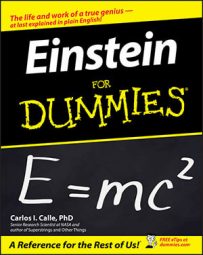Albert Einstein shared his scientific theories and discoveries through numerous books and papers. His theory of relativity made its first appearance in 1905 but was expanded upon and explained in many subsequent writings. The most important of Einstein's writings are listed here:
1905 March 17. The light quantum paper: "On a heuristic point of view concerning the production and transformation of light." This paper gave birth to quantum theory.
1905 June 30. The special theory of relativity: "On the electrodynamics of moving bodies." In this paper, Einstein stated that the laws of physics are the same for all observers in non-accelerated motion and that, for these observers, the speed of light never changes.
1905 September 27. The E = mc2 paper: "Does an object's inertia depend on its energy content?" This paper explained Einstein's discovery that mass and energy are aspects of the same thing; mass and energy are equivalent, and one can be converted into the other.
1911 June. The bending of light prediction: "On the effect of gravity on the propagation of light." This prediction (which was confirmed in 1919) was based on the idea that large objects, like the sun, warp space.
1915 November 15. "On the general theory of relativity." This paper extended Einstein's special theory of relativity to include all types of motion. It took Einstein four years to develop the general theory.
1915 March 20. Einstein's first book, The Foundation of the General Theory of Relativity. This book provided the first complete description of his general theory of relativity.
1916 December. Einstein's best known book, Relativity: The Special and General Theory. This book, which has been reprinted continuously in every major language in the world, contains an accessible description of the two theories of relativity. It uses simple high school mathematics to explain the theories.
1917 The cosmological constant: "Cosmological observations on the general theory of relativity." In this paper, Einstein introduced a correction term to prevent his equations from describing an expanding universe. Although he failed to predict the expansion of the universe (which was discovered later), his cosmological constant is now helping to explain observations about the shape of space and the rate of expansion of the universe.
1935 April. The quantum reality problem: "Can the quantum-mechanical description be considered complete?" Einstein wasn't convinced that quantum theory described reality. Most physicists disagreed with him on this issue. In this paper, he proposed a clever experiment to settle the argument. This experiment was finally performed in the 1980s, and the results indicate that Einstein may have been wrong in this case.

